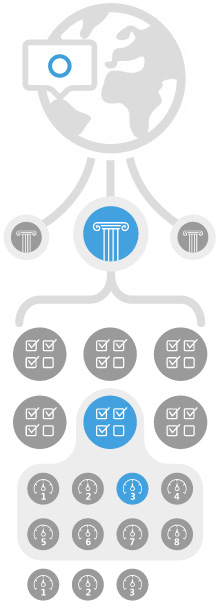-
The Environmental Democracy Index: Ranking Access to Information and Justice
June 2, 2015 By Carley Chavara
Conventional wisdom has been that wealthier countries have better environmental protections than poorer countries. However, a new annual report launched this year, the Environmental Democracy Index, reveals that a strong economy does not necessarily ensure strong environmental rights.
“Environmental democracy” does not refer to representation or free and fair elections, as one might think. Launched by the World Resources Institute (WRI) in partnership with The Access Initiative in Washington, DC, on March 20, the index ranks countries based on citizen’s access to information on environmental quality and problems (transparency), the right to participate meaningfully in decision-making (participation), and the right to seek enforcement of environmental laws or compensation for harm (justice).

The index has three levels of granularity, from these three “pillars,” to 23 guidelines filed under those, and finally 75 indicators that are most specific. Each level feeds into the one above, allowing comparisons at varying degrees. In all, more than 140 environmental lawyers gave 70 countries scores from zero to three for each indicator.
Some of the results are surprising. Russia and South Africa, both countries where natural resource extraction has been tinged with corruption and/or violence, are among the top five highest rated. Lithuania, Latvia, and the United States round out the top five and Haiti ranks last. Comparisons can be made between countries by pillar, guideline, or indicator. For instance, India takes 24th overall but 2nd when it comes to justice, and the United States comes in below average at 42nd when considering the right of the public to challenge state or private actors.
Recognizing that the rules aren’t always followed, the index includes 24 qualitative practice indicators that provide context on the actual strength and frequency of implementation of environmental justice. For instance, some of Russia’s laws were found to be limited in actual use. These qualitative indicators do not figure into the overall score, however, as they are discreet data gathered from desk research and personal visits to agencies rather than public or randomized surveys. While there are plans to expand the practice indicators according to Lalanath De Silva, who directs the EDI project for WRI, the current iteration is more a reflection of laws on the books than reality.
The current scope of the project mainly includes countries participating in The Access Initiative or Open Government Partnership, leaving out much of Western Europe; West, Central, and North Africa; the Middle East; and Central Asia. With more funding, De Silva said at the launch event, they hope to expand in future versions.
“We’re Talking About Rights”
Environmental democracy is a relatively new concept, but the ideas behind it are not. The three components of transparency, participation, and justice are defined in Principle 10 of the Rio Declaration, adopted by the United Nations in 1992. And the Bali Guidelines, adopted by the UN Environment Program in 2010, outline 27 guidelines as implementation steps to address gaps between national legislation and Principle 10 standards.
Other well-known indexes such the Freedom in the World report and the Global Right to Information Rating measure democracy and access to information, but the EDI is the first of its kind to rate public participation laws and access to justice by surveying legislation around the environment specifically, said De Silva.
Accountability empowers communities and provides bottom-up pressure for change“There are still considerable gaps in both laws and practices,” he said. “It is therefore essential that we come up with ways and means to measure progress and identify these gaps so that they can be closed by both governments and civil society working together.”
The idea is that accountability empowers communities and provides bottom-up pressure for change. “It’s a powerful tool for civil society organizations and for just members of the public to become engaged, to point to specific metrics when they try to influence public policy, and effect change and create a broader understanding of environmental conditions,” said Avi S. Garbow, general counsel for the U.S. Environmental Protection Agency.
“When we are talking about environmental democracy, we’re talking about rights,” said Constance Nalegach, head of the Office of International Affairs within Chile’s Ministry of Environment. “You have to address them with the strongest tools available.”
Shared Results, Shared Prosperity?
Rizwana Hasan, chief executive of the Bangladesh Environmental Lawyers Association and a Goldman Environmental Prize winner, said the index could also be useful as a way to learn from others’ mistakes and successes. “We definitely want the right set of environmental principles and development principles to be followed by our leaders at the global level and also at the national level,” she said. “We can’t just follow blindly the development paths that the developed countries thus far have been following and have thus given birth to problems like climate change.”
With basic internet service, anyone can access to the index and compare standards in their country with others. “The theme that we found that lagged the most was public participation,” said Manish Bapna, executive vice president and managing director at WRI. “We believe this index can be a small, yet important step.”
Index results are provisional until the end of August so as to incorporate feedback from a comment period lasting until July 15. Feel free to weigh in with your own thoughts here.
Sources: The Access Initiative, Environmental Democracy Index, The Guardian, National Bureau of Economic Research, Revenue Watch, Transparency Initiative, UN Environment Program, World Resources Institute.
Photo Credit: A dam protest during the 2004 World Social Forum in Mumbai, India, courtesy of flickr user Knut-Erik Helle. Image Credit: Environmental Democracy Index.
 A Publication of the Stimson Center.
A Publication of the Stimson Center.




